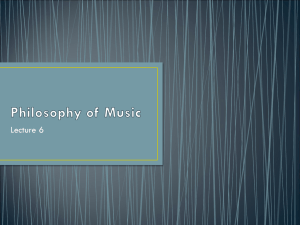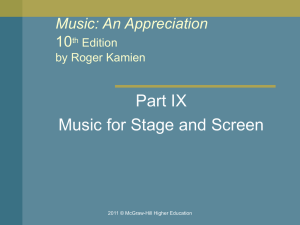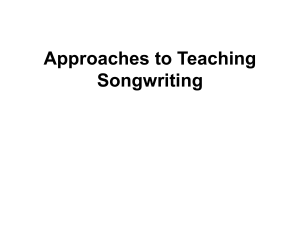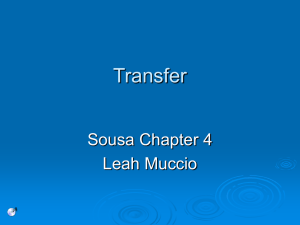A model for music education in New Zealand
advertisement
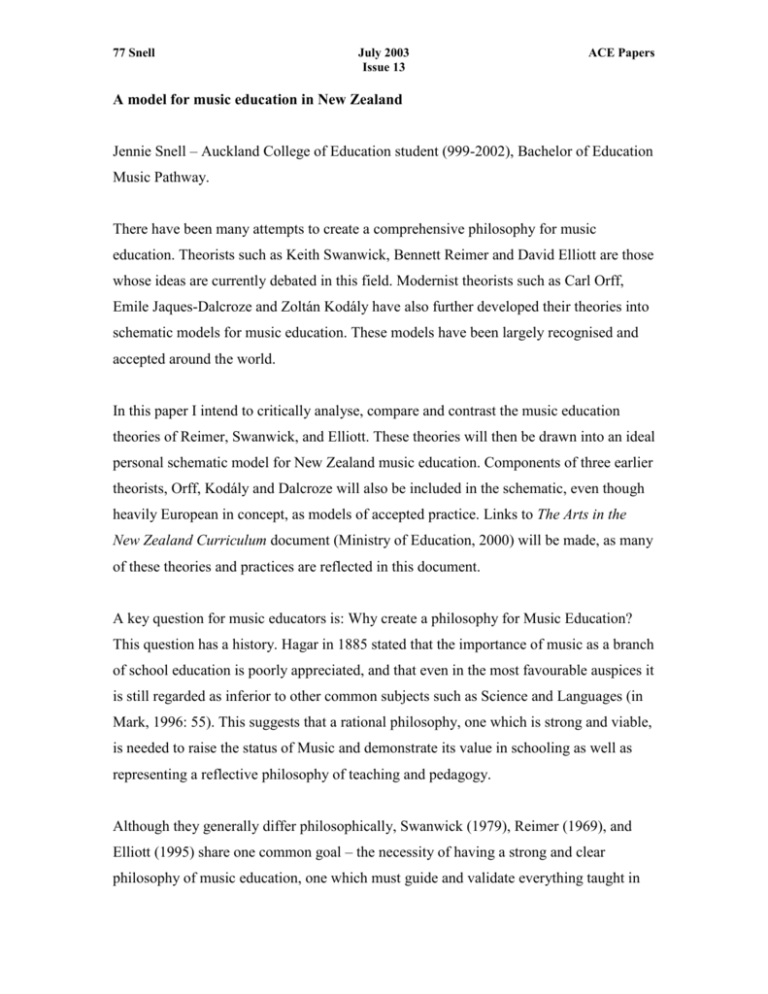
77 Snell July 2003 Issue 13 ACE Papers A model for music education in New Zealand Jennie Snell – Auckland College of Education student (999-2002), Bachelor of Education Music Pathway. There have been many attempts to create a comprehensive philosophy for music education. Theorists such as Keith Swanwick, Bennett Reimer and David Elliott are those whose ideas are currently debated in this field. Modernist theorists such as Carl Orff, Emile Jaques-Dalcroze and Zoltán Kodály have also further developed their theories into schematic models for music education. These models have been largely recognised and accepted around the world. In this paper I intend to critically analyse, compare and contrast the music education theories of Reimer, Swanwick, and Elliott. These theories will then be drawn into an ideal personal schematic model for New Zealand music education. Components of three earlier theorists, Orff, Kodály and Dalcroze will also be included in the schematic, even though heavily European in concept, as models of accepted practice. Links to The Arts in the New Zealand Curriculum document (Ministry of Education, 2000) will be made, as many of these theories and practices are reflected in this document. A key question for music educators is: Why create a philosophy for Music Education? This question has a history. Hagar in 1885 stated that the importance of music as a branch of school education is poorly appreciated, and that even in the most favourable auspices it is still regarded as inferior to other common subjects such as Science and Languages (in Mark, 1996: 55). This suggests that a rational philosophy, one which is strong and viable, is needed to raise the status of Music and demonstrate its value in schooling as well as representing a reflective philosophy of teaching and pedagogy. Although they generally differ philosophically, Swanwick (1979), Reimer (1969), and Elliott (1995) share one common goal – the necessity of having a strong and clear philosophy of music education, one which must guide and validate everything taught in ACE Papers July 2003 Issue 13 Snell 78 the music classroom environment. I will compare the views of these theorists in order to seek a more cohesive philosophical stance. In some sense Reimer and Swanwick are mutually supportive of the notion that music education is, or should be, aesthetic education, but Elliott refutes this concept and proposes his own philosophical ideals. Bennett Reimer has recently retired from his position of Professor Emeritus at the Northwestern University in the United States. Over his career, he has had extensive experience with curriculum design, and many of his principles are clearly reflected in American music curricula. He firmly believes that the foremost purpose of music education is that of an ‘aesthetic education’ and to achieve this goal, music should be explored in regard to its nature and value (Reimer, 1970: 1-2). Reimer believes that all people should have the opportunities to experience quality music education, not simply the elite. The structure of music education programmes should draw upon each individual’s inherent musicality. An aesthetic music programme is one that develops comprehension of the expressive characteristics of music works. To achieve this comprehension, students must have good structural understandings of musical works. Understanding the expressive functions of dynamics, tempo and articulation helps strengthen aesthetic responses (Wiggins, 2001). To be an effective aesthetic music educator, one must possess specialist skills in examining rhythm, melody, harmony, tone colour, texture, dynamics, form, and style, through particular pieces of music. The skill of the educator is then tested in explaining how these elements operate in all music. The aesthetic music educator must have a sound philosophy of practice and take their role seriously. Aesthetic education contains some of those values held in high esteem by the whole of society, these being the values of artistic significance and the significance of human experience. They must also be willing to participate in non-aesthetic activities such as school singing, even though Reimer believes that far too much emphasis is currently placed on singing in general music. When singing is used solely for experiencing and studying music, there are limitations, as it does not meet aesthetic needs (Reimer, 1970: 111-117). 79 Snell July 2003 Issue 13 ACE Papers The author would dispute this notion, and would refer readers to Hungarian teachercomposer Zoltán Kodály who taught the traditional songs of his homeland in school settings with a view to saving cultural identity. Woven into these songs are the values, feelings, culture and belief systems of the Hungarian people. I would ask, how could the songs illustrating the struggles and joys of a nation not be aesthetic music education? Reimer argues that singing is non-aesthetic as it is largely used in the context of assemblies and gatherings. Here it is used as diversion from boredom and to restore order. Reimer believes that this does not fulfil the aesthetic criteria for music education, as the music is “being used as a means towards non-musical ends” (1970: 111), in this case order and regularity. He does state that music educators should not discount the use of school singing, even though it is a non-aesthetic activity, it is another part of the job, but should not be tagged as music education (p112). The music educator has a dual obligation to their students. Firstly, they should encourage those with a gift in music to continue their education, as the art depends on those who will carry it on in the future. Secondly, they must develop and expose all students to develop aesthetic sensitivity, regardless of their musical talent. This is to benefit society as a whole. These two responsibilities are mutually supportive of each other, and will not be effective in isolation (Reimer, 1970: 112). When implementing an aesthetic music programme, Reimer suggests that the model for instruction should be as follows: Musical experience Musical study Musical re-experience (Reimer, 1970: 116). These three principles must be balanced to be effective, and will differ in complexity depending on the students’ ages and abilities. Music in a music programme should be carefully selected. It should display authentic expression, and it should not be artificial. ACE Papers July 2003 Issue 13 Snell 80 Music should reflect diversity, to enable students to see that good music is evident in all the far reaches of the world (Reimer, 1970). Keith Swanwick believes “We have failed to notice and publicize the central core of music education, which is that music education is aesthetic education” (Swanwick 1979: 6). Swanwick’s British educational background is in music cognition, and he believes that the only way to truly understand and experience music is by performing, listening and creating music (Wiggins, 2001: 26). Swanwick believes that developing a musical vocabulary allows people to talk about music. He states “Knowing music is our goal and language can help serve this aim” (Swanwick & Taylor, 1982: 9). Swanwick claims that memorising facts is not all there is to knowledge. He states that …factual knowledge is propositional knowledge, information, or ‘knowing that’. Knowing how is more than knowing that. Knowledge is best acquired first hand (personal knowledge). The distinction between ‘knowing that’ and ‘knowing how’ is clarified through practical demonstration. Technical skills help us find our way in music, but they must not divert us from further musical understanding by over-concentration on virtuosity for virtuosity’s sake. Swanwick stresses that intuition and analysis are interactive. In between ‘that’ and ‘how’ is knowledge by acquaintance, rather like knowing a person, and writers on aesthetics stress that this knowing of is fundamental to the arts. We get it through repeated experience of it. In a musical ‘acquaintance’ we might listen for sequences, or the balance between the parts (Thwaites, 2002, in Music Teach). David Elliott disagrees with Reimer and Swanwick and their belief that music is best understood through examining its aesthetic qualities. Elliott’s background in education is as the Professor of Music in Toronto, Canada. Interestingly, he studied his doctorate with Bennett Reimer. He acknowledges that it was through his studies with Reimer that he began to develop his own philosophy, and debate the aesthetic viewpoints held by him. 81 Snell July 2003 Issue 13 ACE Papers Instead of an aesthetic viewpoint, Elliott proposes a praxial philosophy of music education, which involves developing understandings about music through the “values and meanings evidenced in actual music making and music listening in specific cultural contexts” (Elliott, 1995: 14). His reasoning for refuting the aesthetic concept of music education is due to its “restricted view of musical works and music listening” (p36). He disagrees with Swanwick and Reimer’s focus on the structural elements of music, claiming they ignore the deeper meanings behind its creation. Elliott’s praxial view of music education implies a link between theory and practice. Each different type and style of music has a link back to the groups of people and ideas behind its creation. He disputes the idea that all music can be examined under the same principles (such as the musical elements of rhythm and tone colour), without first examining the history behind it (Elliott, 1995: 14). Listening and performing are not separate entities, they are very much related. Elliott argues that the philosophies of Reimer and Swanwick are concerned only with the structural properties of music, and therefore do not explore all dimensions of musical understanding (ibid: 124). Reimer separates music education into two components, one which is listening-based, accessed by all students in a general music education, and a second, which is a performance-based programme which is for students electing to do music. This idea is largely supported by Swanwick. However, Elliott believes that this creates a double standard, as music education should be the same for all students (Elliott, 1995: 32). In this matter, the author’s support is with Elliott. For who can really choose who is “good enough” to continue making music? All people who wish to carry on their music education into secondary level should be welcomed and supported, not divided and categorised. Using Reimer and Swanwick’s principles, the teacher and school are clearly in control of who may continue their study, and who might be excluded. ACE Papers July 2003 Issue 13 Snell 82 A New Schematic for Music Education The model that I propose for music education is largely based around the theories of Keith Swanwick, with aspects of Reimer and Elliott included. Swanwick suggests a framework for music which uses the mnemonic C (L) A (S) P and this contains three elements that are directly related to music and two elements (in brackets) that have a supporting function. The mnemonic is broken up into these five linked components: C Composition Formulating a musical idea, making a musical object (L) Literature Studies The literature of and the literature about music A Responsive listening as (though not necessarily in) an Audition audience (S) Skill Acquisition Aural, instrumental, notational P Performance Communicating music as a ‘presence’ (Swanwick 1979: 45) This model has been selected as it follows key aspects of the current arts document, and the multi-faceted approach to music education in this country. Being a framework, it also allowed the author to use a degree of personal artistic licence when developing this model for New Zealand music education. The major change that would be made to Swanwick’s CLASP model is that sequential learning outcomes would later be made to break down these key elements into smaller components. Swanwick does not agree with this idea, believing it forces teachers into searching for musical resources merely to illustrate a concept. The broad nature of the Achievement Objectives in the New Zealand Curriculum document does not seem to pose this problem, as teachers have great autonomy in creating their own learning outcomes from the broad based concepts. The use of achievement objectives also helps classroom teachers to create a suitable programme, even with minimal professional development in music education practices. 83 Snell July 2003 Issue 13 ACE Papers Composition Composition, the first facet of the mnemonic, is for Swanwick all forms of musical invention, not simply those which are formally written down using notation. He states that “Composition is the act of making a musical object by assembling sound materials in an expressive way” (Swanwick, 1979: 43). Bavarian Carl Orff and the subsequent Orff Schulwerk movement also supports this belief. A teacher of the Orff methodology provides opportunities at every level for students to explore music, first by imitating rhythmic patterns and phrases, then inventing their own. The ideas can be individually constructed or inspired by the group. This will eventually lead to individual improvisation and composition (Steen 1992). This approach is common in the New Zealand educational setting, particularly the Auckland region. American academic Howard Gardner, believes that composition must be a key element to developing musical intelligence, one component of his Theory of Multiple Intelligences. For Gardner, musical thought is not only “thinking about music; it is thinking in music” (Gardner, 1983, in Wiggins, 2001: 85). Students must have the opportunities to compose their own musical works. If students are only offered performance opportunities, then this could be compared to students learning a language where they are taught to read, but not to speak or write. The connection must be made between the key concepts so students can see the strong links between performing, listening and creating. These concepts form the three major components of the CLASP model. Listening (Audition) Listening is, for Reimer, the “essential mode of musical experiencing” (1970: 120). A good listening programme offers a chance to meet the musical needs of all students, not just those who are skilled performers. Listening skills have the power to go beyond performance and support all learners as they will be able to achieve success in drawing meaning from the music (Reimer, 1997). Through responding to the expressive qualities ACE Papers July 2003 Issue 13 Snell 84 of sound/compositions, students will establish a conscious awareness of expression which will allow them to listen to the music with greater enjoyment (Reimer, 1969: 1). My programme would not only focus on Western European art music but would contain examples of jazz, pop, rock as well as music of the tangata whenua, Pasifika and other world music forms. Performance Performance is an aspect of which Elliott is most passionate. He states “MUSIC is a performing art” (Elliott, 1995: 172) and believes that although all forms of “musicing” are of value, but his priority is that the students’ foundations for learning in and about music should be through the medium of performance. Reimer does not believe that performing music creates aesthetic understanding, it is a means rather than an end and he disagrees with the emphasis placed on performance by the methods of Kodály and Orff. For him, the skill of playing an instrument well is not an aesthetic education (cited in Elliott, 1995: 31). In New Zealand, developing the skills for performance, both vocally and instrumentally, form an important part of music education. In placing too much emphasis on the aesthetic, we can lose sight of the value of the feelings associated with creating and performing music. Literature Studies Literature studies, one of Swanwick’s supporting elements, would find favour with Elliott as he believes that we must understand the cultural traditions and underlying meanings of music, in order to better understand it. He also proposes that we consider a range of forms of musical representation. The Arts in the New Zealand Curriculum document includes statements about music as social and historical texts and claims that through music we can begin too appreciate and understand our diverse New Zealand heritage and other cultures (Ministry of Education, 2000: 52). 85 Snell July 2003 Issue 13 ACE Papers Reimer sees no need to study the cultural significance of music, believing we should concentrate on the sounds and texture, as it is these that have the affective power. Swanwick also believes that music history and the sociology of music are only accessible through the “doors and windows” of musical encounters (Swanwick 1999: 44). This cannot be a complete concept as it does not take into account the critical intention and cultural significance of the composer. The Arts in the New Zealand Curriculum document displays comprehensive guidelines through its strands of Developing Ideas in Music, Communicating and Interpreting in Music, and Understanding Music in Context, which explore structures, conventions and protocols of musical works within a multicultural New Zealand (2000: 54-55). For this author the aesthetic model proposed by Swanwick and Reimer tends to disregard the impact of culture on a work of art. But not every culture can be clearly translated into the aesthetic viewpoint. Skill Acquisition Skill Acquisition is the second supporting element and this relates closely to the pedagogies of Orff, Kodály and Dalcrose. Orff believed that children quite naturally play instruments, sing, move and speak and the emphasis he placed on rhythm led to the creation of the Orff instruments (tuned and untuned percussion instruments). Although these instruments are easy to play, the emphasis should be on studying them to gain competency in their use (Mark, 1996). Kodály used a method which focussed on singing and ear training, one which used the folk songs of his native Hungary in particular. His intention was to have music in the mother tongue, then in other languages, therefore this method would have to be adapted for the New Zealand context. The repertoire would need to be relevant to the children and perhaps a selection of simple New Zealand songs in Mäori and English would help to start the process. ACE Papers July 2003 Issue 13 Snell 86 Dalcroze favoured rhythmic exercises more akin to dance, what he called “eurythmics”. This involves developing rhythmic counterpoint with the body which would increase students’ accuracy in feeling time values. That the supporters of these three methods, (Orff, Kodály and Dalcroze), believe only in the purity of their particular system, and that if that system cannot be taught in its entirety as the music programme then it must not be adopted, is unhelpful to this author. Music teaching is heavily underpinned by belief systems, in particular emotional responses. This means that each educator will value the concepts in different ways. Music educators must either have or follow a clear philosophy to justify their practice if they are to raise the value of music in their students’ lives. References Elliott, D. (1995). Music matters. New York: Oxford University Press. Mark, M. L. (1996). Contemporary music education (3rd ed.). New York: Schirmer Books. Ministry of Education. (2000). The arts in the New Zealand curriculum. Wellington: Learning Media. Reimer, B. (1969). Learning to listen to music. Morristown, NJ: Silver Burdett. Reimer, B. (1970). A philosophy of music education. Englewood Cliffs, NJ: PrenticeHall. Reimer, B. (1997). Music Education in the Twenty-First Century. Music Educator's Journal, November, 1997. Steen, A. (1992). Exploring Orff: A teacher’s guide. New York: Schott Music. Swanwick, K. (1979). A basis for music education. Windsor, UK: NFER-Nelson. Swanwick, K., & Taylor, D. (1982). Discovering music: Developing the music curriculum in secondary schools. London: Batsford Academic and Educational. Swanwick, K. (1999). Teaching music musically. London: Routledge. Thwaites, T. (2002). Keith Swanwick – theories of musical development. Music Teach. Issue 13, Term Four, 2002. Auckland: Dawson-Falls & Associates. Wiggins, J. (2001). Teaching for musical understanding. New York: McGraw-Hill.

